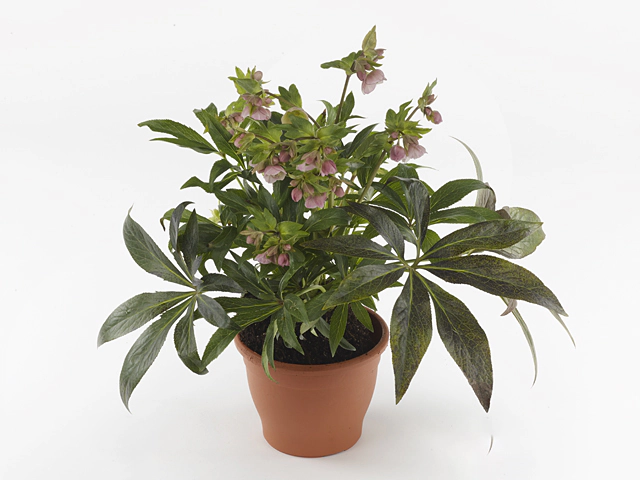Helleborus Dacaya

| Flower type | Single |
| Leaf margin | Serrate |
| Flower color | Pink-medium blue pink-186D |
| Flower diameter | 4,5 - 5 cm |
| Plant height | 30 - 40 cm |
| Leaf size | 20 - 25 cm |
| soil pH requirement | Alkaline (pH > 7,5); Slightly acidic (pH 4,5 - 6,5); Neutral (pH 6,5 - 7,5) |
| Light conditions | Semi-shades |
| Leaf, main color | Dark green |
| Leaf colour, pattern | Unicolored |
| Flower color distribution | Unicolored with trace |
| Toxicity (if consumed) | Toxic |
| Moisture requirements | Well-drained; Moist |
| Soil type | Humus rich |
Helleborus Dacaya, also known as Hellebore, is a stunning flowering plant that adds beauty and elegance to any garden. With its single petal flowers and serrated leaf margins, this plant is a true showstopper.
The flowers of Helleborus Dacaya come in a delightful shade of pink, with hints of medium blue, giving them a unique and eye-catching color. The flower diameter ranges from 4.5 to 5 cm, creating a lovely size for the blooms. Growing to a height of 30 to 40 cm, this plant is perfect for adding a pop of color to borders or even potted arrangements.
The leaves of Helleborus Dacaya are just as impressive as its flowers. With a size of 20 to 25 cm, the dark green leaves create a lush and vibrant backdrop for the pink blooms. The leaf color is unicolored, providing a beautiful contrast against the vibrant flowers.
When it comes to soil requirements, Helleborus Dacaya is quite versatile. It thrives in alkaline soil with a pH higher than 7.5. It can also tolerate slightly acidic soil with a pH ranging from 4.5 to 6.5, as well as neutral soil with a pH between 6.5 and 7.5. This adaptability makes it suitable for a wide range of garden settings.
In terms of lighting conditions, Helleborus Dacaya prefers semi-shades. It thrives in areas with partial sunlight, making it an excellent choice for gardens with dappled or filtered light. This makes it a great option for planting under trees or in areas with limited direct sunlight.
Helleborus Dacaya is a toxic plant if consumed, so it is important to keep it away from children and pets. However, its toxicity does not detract from its beauty and overall appeal. As long as precautions are taken, this plant can be enjoyed safely.
Moisture requirements for Helleborus Dacaya include well-drained soil and moderate moisture levels. It is important to avoid overwatering, as this can lead to root rot. However, keeping the soil consistently moist will help the plant thrive and promote healthy growth.
The soil type preferred by Helleborus Dacaya is humus-rich. This type of soil provides essential nutrients and promotes healthy root development. Adding organic matter, such as compost or well-rotted manure, can greatly improve the soil's humus content and ensure optimal conditions for this plant.
In conclusion, Helleborus Dacaya is a stunning flowering plant that adds a touch of elegance to any garden. With its beautiful pink and blue flowers, dark green leaves, and adaptability to a wide range of soil and light conditions, it is a versatile and attractive choice for both novice and experienced gardeners. However, it is important to remember that this plant is toxic if consumed, so caution must be taken. Overall, Helleborus Dacaya is a must-have for any garden lover looking to add a touch of beauty and sophistication to their outdoor space.
Market availability index by month:
| Jan. | Feb. | Mar. | Apr. | May | Jun. | Jul. | Aug. | Sep. | Oct. | Nov. | Dec. |
|---|---|---|---|---|---|---|---|---|---|---|---|
| 2 | 2 | 1 | - | - | - | - | 1 | 2 | 3 | 4 | 3 |